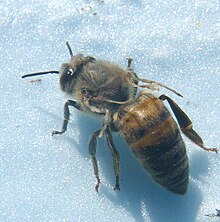Animal virus
Animal viruses are viruses that infect animals. Viruses infect all cellular life and although viruses infect every animal, plant, fungus and protist species, each has its own specific range of viruses that often infect only that species.[1]
Vertebrates
The viruses of vertebrates are informally distinguished between those that primarily cause infections of humans and those that infect other animals. The two fields of study are called medical (or clinical) virology and veterinary virology respectively.[2] Although not the first viruses to be discovered and characterised,[3] those that cause infections of humans are the most studied.[4] Different viruses can infect all the organs and tissues of the body and the outcomes range from mild or no symptoms, to life-threatening diseases.[5] Humans cannot be infected by plant or insect viruses, but they are susceptible to infections with viruses from other vertebrates. These are called viral zoonoses or zoonotic infections.[6] Examples include, rabies, yellow fever and pappataci fever.[7]
The viruses that infect other vertebrates are related to those of humans and most families of viruses that cause human diseases are represented.

Companion animals such as cats, dogs, and horses, if not vaccinated, can catch serious viral infections.
Marine mammals are susceptible to viral infections. In 1988 and 2002, thousands of
Fish too have their viruses. They are particularly prone to infections with rhabdoviruses, which are distinct from, but related to rabies virus. At least nine types of rhabdovirus cause economically important diseases in species including salmon, pike, perch, sea bass, carp and cod. The symptoms include anaemia, bleeding, lethargy and a mortality rate that is affected by the temperature of the water. In hatcheries the diseases are often controlled by increasing the temperature to 15–18 °C.[20] Like all vertebrates, fish suffer from herpes viruses. These ancient viruses have co-evolved with their hosts and are highly species-specific.[21] In fish, they cause cancerous tumours and non-cancerous growths called hyperplasia.[22]
Invertebrates

Arthropods is the largest group of animals and has shown to be a major reservoir of different viruses, both insect-specific viruses (ISV) and viruses that can infect both vertebrates and invertebrates, more known as arthropod-borne viruses (arboviruses). Insect-specific viruses are, as the name reveals, characterised by their incapacity to infect vertebrates. This can be assessed through, viral inoculation of mammalian, avian, or amphibian cell lines.[23] The first (ISV) was discovered over 40 years ago by Stollar and Thomas.[24] It was isolated from an Aedes aegypti cell culture where a large number of syncytia were observed and the virus was named cell fusing agent virus (CFAV). Further, when inoculated on different vertebrate cell lines no cytopathic effect (CPE) could be observed and the virus could not be re-isolated, suggesting that the virus must be insect-specific.[24]
Invertebrates do not produce antibodies by the lymphocyte-based adaptive immune system that is central to vertebrate immunity, but they are capable of effective immune responses.[25] Phagocytosis was first observed in invertebrates,[26] and this and other innate immune responses are important in immunity to viruses and other pathogens. The hemolymph of invertebrates contains many soluble defence molecules, such as hemocyanins, lectins, and proteins, which protect these animals against invaders.[27]
The health of the honey bee has been important to human societies for centuries.
Viruses can also change the behaviour of their insect hosts to their own advantage. A baculovirus of the gypsy moth (Lymantria dispar) makes their caterpillars climb to the tops of trees where they die. In doing so, they release a shower of millions of progeny viruses that go on to infect more caterpillars.[37]
References
- ^ Leppard p. 3
- ^ Murphy, p.ix
- ^ Leppard, pp. 4–6
- ISBN 9780443073670.
- ^ Leppard, p. 295
- ^ Leppard, pp. 268–9
- ^ Leppard, p. 269
- ^ Murphy pp. 587–599
- PMID 18035428.
- ^ MacLachlan p. 160
- PMID 22333483.
- PMID 16316389.
- ^ Murphy p. 351
- PMID 9129667.
- ^ Murphy p. 169
- ^ Murphy p.423
- ^ Hall, A. J., Jepson, P. D., Goodman, S. J. & Harkonen, T. "Phocine distemper virus in the North and European Seas — data and models, nature and nurture". Biol. Conserv. 131, 221–229 (2006)
- ^ Murphy p. 426
- S2CID 4658457.
- ^ Murphy pp. 442–443
- ^ Murphy p. 324
- ^ Murphy 325
- PMID 30632016.
- ^ PMID 806166.
- S2CID 25041997.
- ^ "Ilya Mechnikov". The Nobel Foundation. Retrieved November 28, 2008.
- PMID 15826490.
- PMID 22032828.
- PMID 17765703.
- PMID 22235317.
- ^ PMID 9878295.
- S2CID 21852438.
- ISBN 1596916397
- ^ Mahy (a) p. 426
- ^ Moscardi F. Use of viruses for pest control in brazil: The case of the nuclear polyhedrosis virus of the soybean caterpillar, Anticarsia gemmatalis. Memórias do Instituto Oswaldo Cruz, Rio de Janeiro. 1989;84:51–56.
- S2CID 11008585.
- S2CID 20400126.
Bibliography
- Leppard, Keith, Nigel Dimmock, Easton, Andrew (2007). Introduction to Modern Virology. Blackwell Publishing Limited. ISBN 978-1-4051-3645-7.
- Mahy B. W.J., Van Regenmortel MHV, eds. (2009). Desk Encyclopedia of General Virology. Oxford: Academic Press. ISBN 978-0-12-375146-1.
- Murphy, FA, Gibbs, EPJ, Horzinek, MC, Studdart MJ (1999). Veterinary Virology. Boston: Academic Press. ISBN 978-0-12-511340-3.

